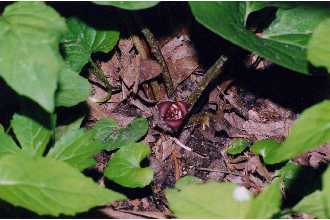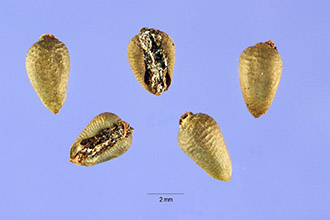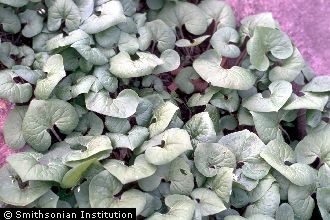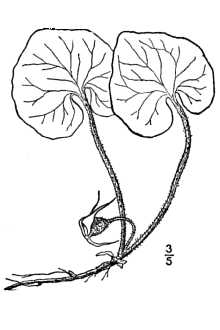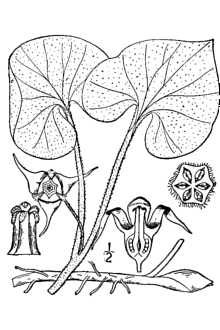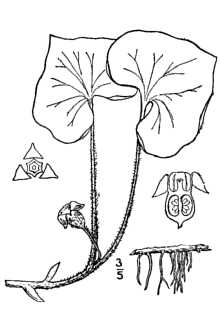Asarum canadense L. var. acuminatum Ashe
Scientific Name: Asarum canadense L. var. acuminatum Ashe
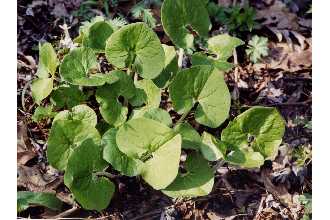
| General Information | |
|---|---|
| Usda Symbol | ASCAA |
| Group | Dicot |
| Life Cycle | Perennial |
| Growth Habits | Forb/herb |
| Native Locations | ASCAA |
Plant Guide
Alternate Names
Canadian snakeroot
Uses
Ethnobotanic: The Abnaki used a decoction of the plant in combination with another plant for the treatment of colds. The Ojibwe used the roots of this plant as an appetizer by putting it in any food as it was being cooked. It was also used for indigestion. The Iroquois used the roots to treat scarlet fever, colds, urinary disorders, and headaches. The Cherokee used the plant for a wide variety of medicinal purposes. The roots were used to treat coughs, colds, heart trouble, and blood medicine. The Meskwaki used the roots for many things. The cooked root was put into the ear for earache or sore ears. When one could not eat certain things, this root was cooked with these foods and it rendered them palatable. Mud catfish were cooked with Canadian wildginger to improve its flavor. When the root was chewed and the fisherman used the spittle on the bait, it enabled him to catch catfish. The Menomini used the fresh or dried roots of Canadian wildginger as a mild stomachic. When the patient was weak or had a weak stomach and it might be fatal to eat something he craved, he was fed a part of this root. Whatever he wanted could then be eaten with impunity. The Micmac also used the root as a stomachic and to treat cramps. The Potawatomi used the root to flavor meat or fish and render otherwise inedible food, palatable. Wildlife: Canadian wildginger is an alternate food source for the pipevine swallowtail butterfly (Battus philenor).
Status
Please consult the PLANTS web site and your State Department of Natural Resources for this plant’s current status, such as, state noxious status and wetland indicator values. © William S. Justice @ PLANTS
Description
General: Birthwort Family (Aristolochiaceae), This herbaceous perennial is hairy, especially the petioles and calyx, The leaves are cordate-rotund to cordate-reniform, mostly 8-12 cm wide at anthesis, and larger at maturity, The solitary, red-brown flowers are 2-4 cm, They are short peduncled, arising between the pair of leaves, The fruit is capsular, opening irregularly, The seeds are large, ovoid, and wrinkled, The rhizome produces annually a pair of petiolate, broad, hairy leaves and these are deciduous at the end of the season, Use soil moisture sensors to measure the soil moisture of Asarum canadense L. var. acuminatum Ashe.,
Distribution
For current distribution, please consult the Plant Profile page for this species on the PLANTS Web site. This plant is found in rich woods, usually in colonies from New Brunswick and Quebec to Ontario and Minnesota, south to North Carolina, northern Alabama, and northern Louisiana.
Establishment
Propagation by seeds: This plant is somewhat difficult to start from seed and much easier by division. Gather the mealy fruits when they first begin to split. Clean the seeds, washing off all of the pulp that might inhibit germination and sow them outdoors immediately. They should be planted in a shaded seedbed and well watered throughout the summer for good germination the following spring. Note that the seeds of Canadian wildginger, if stored before planting, should not be kept dry. They should be placed in sealed plastic bags at 40° F and in slightly moist vermiculite. Seeds can also be sown in plugs and transferred several times to larger pots. They should be place in a greenhouse for three months and then moved to a cold frame for three months before planting out in the garden. Propagation by division: Divide mature plants in early autumn when they start to go dormant. With the appropriate garden tool, cut through the rhizome at intervals of 6-8 inches. Another method is to leave the parent plant in place and divide sections from the edges of the clump. Replant the new divisions right away and water them thoroughly. Cultivars, Improved and Selected Materials (and area of origin) These plant materials are readily available from native plant nurseries within the species range.

